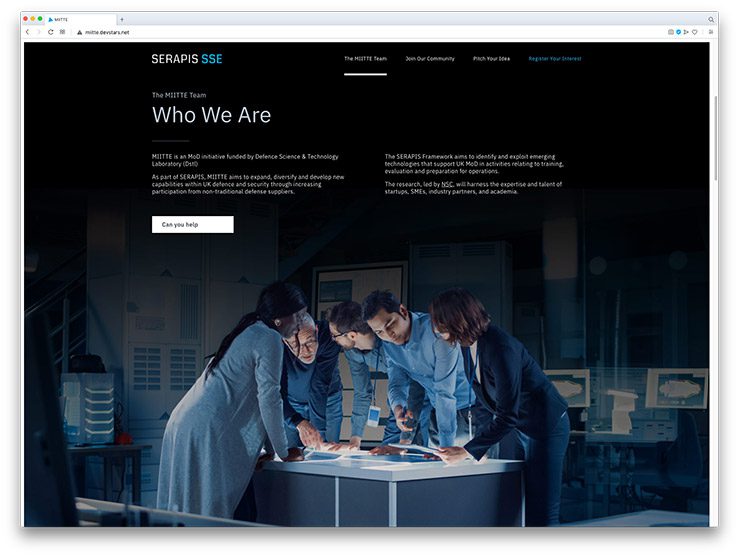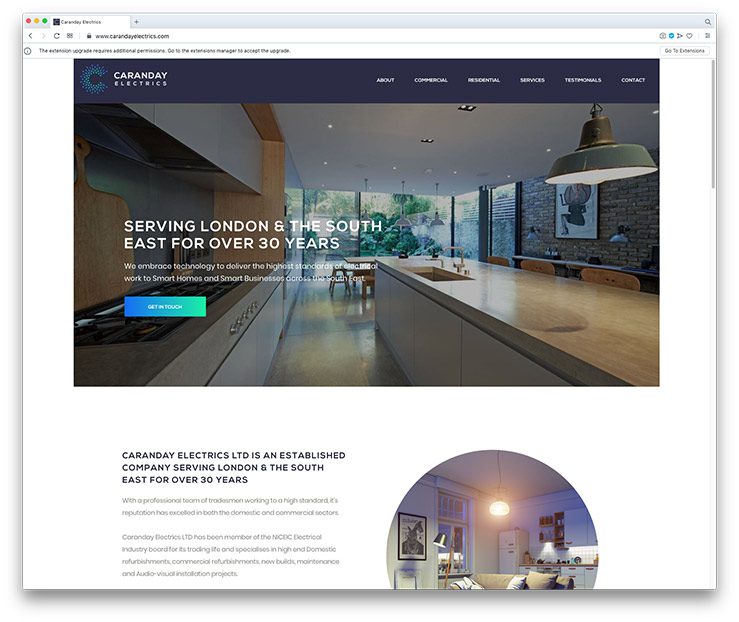
Article
One page vs multi page websites
PUBLISHED:October 22, 2020
UPDATED:November 1, 2023
In recent years, one-page websites have gained significant popularity. It seems like every week a new one-page website pops up, and the trend shows no signs of slowing down. But the question remains, is a one-page website the ideal solution for your business, or should you be considering a multi-page site to maximize your online effectiveness?
In this article, we will explore some of the key differences between a one-page website design and a multi-page website, helping you make an informed decision for your business.
The Benefits and Drawbacks of a Single-Page Website
Let’s start by examining the pros and cons of running a single-page website for your business or brand.
The benefits of a single-page website
Cost-Effective
Single-page websites offer a compelling and budget-friendly solution, making them an ideal choice for startups operating with limited financial resources.
Unlike multi-page sites, which require multiple pages, each with its own design and content, single-page websites condense all the essential information onto a single, vertically scrolling page. This streamlined structure minimizes the time and resources required for one-page design and development, making them a great choice for startups with limited funds.
User-Friendly
Single-page websites offer an enhanced user experience, especially on mobile devices, by simplifying navigation through seamless scrolling which is easier than clicking.
Single-page sites load faster, appear less cluttered on smaller screens, support engaging storytelling, and tend to have better conversion rates. This user-centric approach to web design improves satisfaction and potentially increases business conversions.
Focus on Key Message
Single-page websites demand clear and concise messaging, compelling headlines, succinct copy, and eye-catching visuals. This precision in communication ensures that visitors quickly understand a business’s core message and offerings. It also streamlines the user experience and guides them seamlessly through the content.
Speed
Single-page websites offer efficient and quick development due to their streamlined structure. Their simplicity reduces development time, testing efforts, and loading times, making them an ideal choice for businesses aiming for a speedy online presence.
Flexibility
A single-page design approach offers businesses the flexibility to grow gradually as their needs change. This cost-effective approach allows for the addition of new sections over time, ensuring design consistency and improved SEO. It enables businesses to adapt to market changes and respond to evolving customer demands efficiently.
While these advantages are appealing, there are also some drawbacks to consider.
The drawbacks of a single-page website
Limited Competitiveness
Multi-page websites often have an advantage over single-page sites in search engine results due to their versatility in targeting a wide range of keywords and topics. Single-page websites may struggle in competitive markets, but they can compete effectively by prioritizing high-quality content, maintaining content consistency, and implementing strategic SEO practices.
Limited Metadata
Limited metadata in single-page websites poses challenges for SEO. Metadata, crucial for search engine ranking, is constrained, limiting keyword targeting and potentially affecting visibility in search results. However, businesses can address this limitation with strategic optimization, quality content, semantic markup, and an engaging user experience. Innovative solutions such as anchor links on internal pages can also help enhance SEO for higher ranking on search engines.
Keyword Dilution
The drawback of targeting a wide range of keywords effectively in single-page websites arises from their limited structure. Unlike multi-page sites, single-page websites consolidate content into one single web page, limiting keyword diversity. These sites must focus on a select few keywords, potentially reducing visibility for alternative search terms.
To address this limitation, strategic keyword selection and optimization are essential. Each section of the single page should be optimized for unique keywords, while high-quality content plays a crucial role in attracting organic traffic. Despite the challenge, single-page websites can enhance SEO by making the most of their limited keyword targeting.
High Bounce Rate
The high bounce rate in single-page websites is a concern because visitors often leave quickly after arriving. This is due to limited engagement opportunities, content relevance, user expectations, and the need for effective calls to action.
Mitigating the high bounce rate challenge in single-page websites requires an in-depth understanding of user behaviour, meticulous content design, compelling CTAs, and responsive minimalist design. By strategically addressing these factors, businesses can reduce bounce rates and enhance the overall user experience on their single-page sites.
Despite the risk of a high bounce rate, there may be one saving grace…
Improve Single-Page Website SEO with Engagement Rate
Google’s shift from bounce rate to an engagement metric signifies a more nuanced evaluation of user interaction with websites. This change can benefit single-page websites by considering factors beyond immediate exits.
With an engagement-focused system, factors like time spent on the page and interaction with content become more critical. This means that even if users bounce from a single-page website, they may not be penalized as severely as before. However, challenges related to metadata and keyword dilution still exist. so the best one-page websites need to pay attention to their keyword strategies.
The benefits and drawbacks of a multi-page site
Now, let’s consider the advantages and disadvantages of multi-page websites.
The Benefits of a Multi-page Website
Improved SEO
Multi-page websites excel in SEO due to their ability to accommodate a wide range of keywords and enhance user engagement. The diversity of keywords, comprehensive content, dynamic user experience, internal linking, and specific landing pages for products and services all contribute to their strong SEO potential. This makes multi-page websites highly effective in search engine rankings and engaging website visitors.
Increased Competitiveness
Businesses offering multiple products or services can efficiently segment their offerings across different pages. Each product or service can have its dedicated page, allowing for in-depth descriptions, specifications, and tailored content. This segmentation simplifies user navigation and ensures that potential customers find precisely what they are looking for, ultimately increasing the likelihood of conversion.
Scalability
The flexibility to add new content, products, and services easily as a business grows is a paramount advantage of multi-page websites. This attribute facilitates dynamic expansion and contributes to the entire website’s long-term relevance.
Multi-page websites are inherently scalable. They can adapt to the evolving needs of a business without requiring a complete site overhaul. When a business introduces new products or services, it can simply create dedicated pages for them. This ensures that the website remains current and aligned with the company’s growth strategy.
Keeping a website up to date is vital in the digital age. Multi-page websites allow businesses to provide relevant information and offerings to their audience promptly. Whether it’s launching new products, announcing services, or sharing the latest company news, these updates can be integrated seamlessly.
Lastly, Multi-page websites enable businesses to create landing pages which can be tailored for marketing and promotional campaigns. These targeted pages can effectively capture the attention of potential customers and drive conversions.
Builds Trust
The perception of trustworthiness in the online world is a pivotal factor influencing consumers’ decisions, and multi-page websites possess distinct advantages in this regard.
Multi-page websites offer ample space for businesses to provide comprehensive information about their products, services, and company. This extensive content demonstrates transparency, giving potential customers a more in-depth understanding of what they can expect. Trust is built on clarity, and multi-page sites excel in providing that clarity.
The presence of a contact form and customer reviews enhances user engagement and trust. Customers rely on the experiences and opinions of others when making purchasing decisions. Multi-page websites can incorporate customer testimonials, case studies, and reviews, offering social proof that the business delivers on its promises.
Larger, well-organized websites exude professionalism. They convey a sense of seriousness and commitment to the customer, which fosters trust. A professionally built multi-page site, with a modern design, clear navigation menu and well-structured content, presents the company as a credible and established entity.
The drawbacks of a multi-page website
Content Creation
The demand for creating content for multiple pages, particularly for smaller teams, presents several noteworthy challenges. For small businesses, allocating resources for content creation across numerous pages can be daunting. It requires a careful balance between maintaining existing content and consistently generating new material. Small business owners often have limited personnel dedicated to content creation, forcing team members to wear multiple hats, which can lead to burnout and decreased productivity.
Maintaining the quality and consistency of content can be challenging with limited resources. Rushed or subpar content can harm the website’s reputation and SEO efforts. Smaller teams may struggle to consistently produce high-quality content that engages and informs visitors.
Keeping content up-to-date is essential for SEO and user experience. Smaller teams may face difficulties in managing and updating content across numerous pages, risking outdated information that can deter users and harm search engine rankings.
Ongoing Management
The management demands of larger multi-page websites are substantial and encompass a range of critical tasks, including ongoing SEO content creation and updates.
Building and maintaining high-quality external and internal links is essential for SEO. Larger websites have a more extensive network of links to manage, necessitating a dedicated strategy for link building and monitoring.
Ongoing Maintenance
Larger websites may use complex technical elements, such as e-commerce platforms or content management systems. These require regular updates and maintenance to ensure the website’s continued functionality.
The larger the website, the more attractive it becomes to potential security threats. Regular security audits, updates, and monitoring are imperative to protect user data and maintain the site’s integrity.
Failing to address these aspects can lead to diminishing user trust, lower search engine rankings, technical issues, and potential security breaches. Thus, a commitment to regular updates and maintenance is a non-negotiable requirement for the ongoing success of a larger website.
Keeping User Attention
Managing user focus and preventing confusion is a vital consideration for multi-page websites, particularly those with an extensive array of options and information.
This phenomenon, known as “choice overload,” occurs when users are presented with so many choices that they struggle to make a decision. This can result in decision fatigue and an increased likelihood of users exiting the site without completing their intended task.
Maintaining a clear and straightforward user journey is essential. Users should easily understand where to find the most important information and how to take desired actions, such as making a purchase or submitting an inquiry. If the website offers too many options without clear guidance, users may become frustrated, leading to a negative user experience.
Every page on a multi-page website should have a specific purpose and guide users toward a particular task or goal. Overcrowding pages with unrelated information or options can divert users’ attention from the intended task, making it harder for them to complete actions and achieve their objectives. Ultimately this leads to fewer conversions.
User Journey
Multi-page websites, particularly those with numerous pages and subpages, can suffer from navigation clutter. Complex menus, excessive links, and intricate hierarchies can overwhelm users, making it challenging to find their desired content. It’s crucial to simplify and streamline navigation to prevent users from feeling lost or frustrated.
Maintaining consistent navigation across all pages is essential. Users should be able to rely on a familiar menu structure and navigation elements, regardless of which page they’re on. Inconsistencies can lead to confusion and hinder ease of use, emphasizing the need for vigilant monitoring and upkeep.
With the growing prevalence of mobile browsing, ensuring that complex navigation remains user-friendly on smaller screens is crucial. Multi-page websites need a responsive design that adapts to various devices, maintaining intuitive navigation. Failing to address mobile usability can result in a poor experience for mobile users.
Users often rely on clear navigation to guide them through a website. Complex navigation systems may necessitate additional elements like breadcrumbs, sitemaps, or contextual cues to assist users in understanding their location and available paths.
Regular usability testing and gathering user feedback are vital for identifying and rectifying navigation issues. Complex navigation systems should be continuously assessed to detect and address user experience challenges, ensuring a smooth and frustration-free journey.

In conclusion: Choosing the Right Website
The choice between a single-page or multi-page website should be guided by a thoughtful evaluation of your business requirements, while carefully considering the advantages and disadvantages of each option. Here’s a brief breakdown to assist you in making an informed decision:
- Single-Page Sites: These are an excellent fit for startups with limited budgets and a specific customer base. If you’re launching a new business, selling a single product, or promoting a one-time event with off-site traffic sources (such as social media or email marketing), a single-page website can effectively convey your message and engage your audience. Its cost-effective nature and simplicity are well-suited to these scenarios, allowing you to make a strong first impression without breaking the bank.
- Small Business Websites: Small businesses often have diverse needs. Depending on your specific requirements, you may opt for a single-page site to keep things concise and straightforward, or you might choose a multi-page approach to provide additional information and cater to a broader audience. Consider the balance between cost, user experience, and the depth of content you need to offer.
- Established Companies: Established companies looking to boost their SEO, expand their online presence, and cater to a broader customer base are better served by multi-page websites. These websites offer the scope for in-depth content, product or service segmentation, and SEO optimization. They also convey a sense of professionalism and authority that aligns with the expectations of a larger and more diverse clientele.
Ultimately, the decision should align closely with your business goals, objectives and available resources. Choose the website format that best serves your brand’s unique requirements and effectively communicates your message to your target audience. Your website is a digital reflection of your business, so make a choice that aligns with your brand identity and long-term growth strategy.
Need a new multi-page or single-page website?
If after reading this article you’re still not sure about having a multi-page or single-page design for your new website, drop us a line and we’ll help you find the right solution.
Need to see some single-page website examples?
Below you’ll find a selection of our best one-page website examples. Each of our one-page website templates is created bespoke to our client’s needs, so if you don’t see what you need, just drop us a line and we’ll discuss your requirements in more detail.
One-page Website FAQ
One-page websites can work for e-commerce, especially if you have a limited product range. However, for a larger online store, multi-page sites are more practical.
To enhance the SEO of your one-page website, focus on optimizing your metadata, using relevant keywords, and ensuring engaging content. Monitor the new engagement metrics provided by Google.
Consider your budget, the nature of your business, your target audience, and your long-term growth plans. These factors will help you make an informed decision.
Yes, it’s possible to transition from a one-page website to a multi-page site as your business grows and your needs change.
Work closely with your web development team to create a user-friendly navigation structure, and guide users effectively to prevent them from feeling lost on your site.





